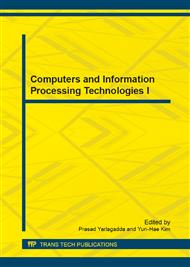[1]
A. Bulling, U. Blanke, and B. Schiele, A tutorial on human activity recognition using body-worn inertial sensors, ACM Computing Surveys (CSUR), vol. 46, p.33, (2014).
DOI: 10.1145/2499621
Google Scholar
[2]
N. Kern, B. Schiele, and A. Schmidt, Multi-sensor activity context detection for wearable computing, in Ambient Intelligence, ed: Springer, 2003, pp.220-232.
DOI: 10.1007/978-3-540-39863-9_17
Google Scholar
[3]
J. Lester, T. Choudhury, N. Kern, G. Borriello, and B. Hannaford, A Hybrid Discriminative/Generative Approach for Modeling Human Activities, in IJCAI, 2005, pp.766-772.
Google Scholar
[4]
U. Maurer, A. Rowe, A. Smailagic, and D. Siewiorek, Location and activity recognition using eWatch: A wearable sensor platform, in Ambient Intelligence in Everyday Life, ed: Springer, 2006, pp.86-102.
DOI: 10.1007/11825890_4
Google Scholar
[5]
T. Gu, L. Wang, Z. Wu, X. Tao, and J. Lu, A pattern mining approach to sensor-based human activity recognition, Knowledge and Data Engineering, IEEE Transactions on, vol. 23, pp.1359-1372, (2011).
DOI: 10.1109/tkde.2010.184
Google Scholar
[6]
A. M. Khan, Y. -K. Lee, S. Y. Lee, and T. -S. Kim, A triaxial accelerometer-based physical-activity recognition via augmented-signal features and a hierarchical recognizer, Information Technology in Biomedicine, IEEE Transactions on, vol. 14, pp.1166-1172, (2010).
DOI: 10.1109/titb.2010.2051955
Google Scholar
[7]
J. R. Kwapisz, G. M. Weiss, and S. A. Moore, Activity recognition using cell phone accelerometers, ACM SigKDD Explorations Newsletter, vol. 12, pp.74-82, (2011).
DOI: 10.1145/1964897.1964918
Google Scholar
[8]
Y. -S. Lee and S. -B. Cho, Activity recognition using hierarchical hidden markov models on a smartphone with 3D accelerometer, in Hybrid Artificial Intelligent Systems, ed: Springer, 2011, pp.460-467.
DOI: 10.1007/978-3-642-21219-2_58
Google Scholar
[9]
Ó. D. Lara, A. J. Pérez, M. A. Labrador, and J. D. Posada, Centinela: A human activity recognition system based on acceleration and vital sign data, Pervasive and mobile computing, vol. 8, pp.717-729, (2012).
DOI: 10.1016/j.pmcj.2011.06.004
Google Scholar
[10]
D. Anguita, A. Ghio, L. Oneto, X. Parra, and J. L. Reyes-Ortiz, Human activity recognition on smartphones using a multiclass hardware-friendly support vector machine, in Ambient Assisted Living and Home Care, ed: Springer, 2012, pp.216-223.
DOI: 10.1007/978-3-642-35395-6_30
Google Scholar
[11]
T. Maekawa, Y. Yanagisawa, Y. Kishino, K. Ishiguro, K. Kamei, Y. Sakurai, et al., Object-based activity recognition with heterogeneous sensors on wrist, in Pervasive Computing, ed: Springer, 2010, pp.246-264.
DOI: 10.1007/978-3-642-12654-3_15
Google Scholar
[12]
J. Parkka, L. Cluitmans, and M. Ermes, Personalization algorithm for real-time activity recognition using PDA, wireless motion bands, and binary decision tree, Information Technology in Biomedicine, IEEE Transactions on, vol. 14, pp.1211-1215, (2010).
DOI: 10.1109/titb.2010.2055060
Google Scholar
[13]
L. Atallah, B. Lo, R. King, and G. -Z. Yang, Sensor positioning for activity recognition using wearable accelerometers, Biomedical Circuits and Systems, IEEE Transactions on, vol. 5, pp.320-329, (2011).
DOI: 10.1109/tbcas.2011.2160540
Google Scholar
[14]
S. Abdullah, N. D. Lane, and T. Choudhury, Towards Population Scale Activity Recognition: A Framework for Handling Data Diversity, in AAAI, (2012).
DOI: 10.1609/aaai.v26i1.8323
Google Scholar
[15]
M. Keally, G. Zhou, G. Xing, J. Wu, and A. Pyles, Pbn: towards practical activity recognition using smartphone-based body sensor networks, in Proceedings of the 9th ACM Conference on Embedded Networked Sensor Systems, 2011, pp.246-259.
DOI: 10.1145/2070942.2070968
Google Scholar
[16]
T. Maekawa and S. Watanabe, Unsupervised activity recognition with user's physical characteristics data, in Wearable Computers (ISWC), 2011 15th Annual International Symposium on, 2011, pp.89-96.
DOI: 10.1109/iswc.2011.24
Google Scholar
[17]
C. Zhu and W. Sheng, Wearable sensor-based hand gesture and daily activity recognition for robot-assisted living, Systems, Man and Cybernetics, Part A: Systems and Humans, IEEE Transactions on, vol. 41, pp.569-573, (2011).
DOI: 10.1109/tsmca.2010.2093883
Google Scholar
[18]
S. Lee, H. X. Le, H. Q. Ngo, H. I. Kim, M. Han, and Y. -K. Lee, Semi-Markov conditional random fields for accelerometer-based activity recognition, Applied Intelligence, vol. 35, pp.226-241, (2011).
DOI: 10.1007/s10489-010-0216-5
Google Scholar
[19]
E. Alpaydin, Introduction to machine learning: MIT press, (2004).
Google Scholar
[20]
J. D. Rennie, L. Shih, J. Teevan, and D. R. Karger, Tackling the poor assumptions of naive bayes text classifiers, in ICML, 2003, pp.616-623.
Google Scholar
[21]
H. Abdi and L. J. Williams, Principal component analysis, Wiley Interdisciplinary Reviews: Computational Statistics, vol. 2, pp.433-459, (2010).
DOI: 10.1002/wics.101
Google Scholar
[22]
B. Scholkopft and K. -R. Mullert, Fisher discriminant analysis with kernels, (1999).
Google Scholar


